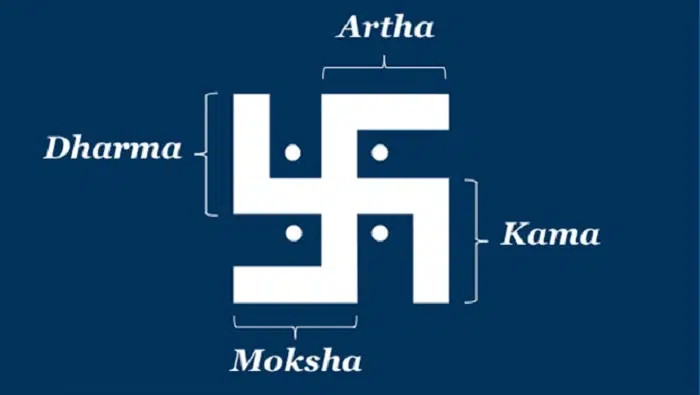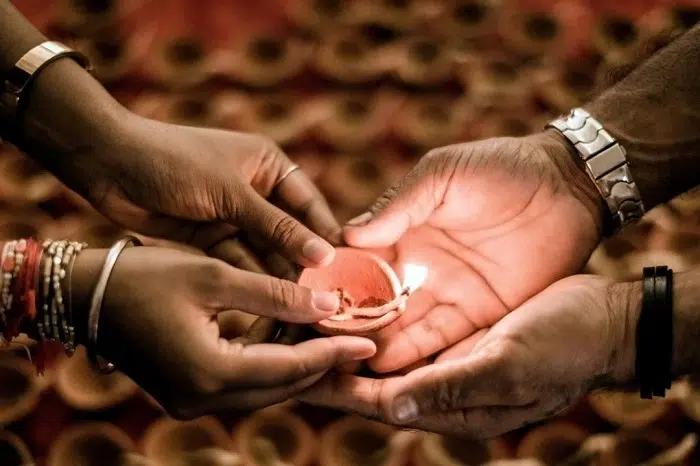Few are the signs in India that are presented with such godliness and sanctity as the Swastik sign. It is used on doors, temples, and offices as well and is one of the world’s oldest and most powerful peace, prosperity, and God’s blessings signs. The Swastik was present thousands of years ago as an Indian culture sign and even today symbolizes hope and trust.
The word “Swastik” came from the Sanskrit term “Su-Astik.” It signifies “good existence” or “well-being.” The symbol consists of four arms bent in right angles to one another, enclosing a cross whose extensions move in a clockwise direction. It’s a very ancient symbol and signifies good fortune, purity, and spiritual power.
The article provides an explanation of the definition, form, and meaning of the Swastik symbol to live, place laws, forms, and how to draw it.
What Is the Swastik Symbol
It is a very ancient and auspicious symbol of Hinduism, Buddhism, and Jainism. It is a four-armed cross. It is bent at right angles. It is revolving in the anticlockwise direction.
It is an indicator of good luck, good fortune, and protector. It is kept in temples, ceremonies, and at the door of the house to impart God’s blessings and good luck.
| Feature | Description |
| Sanskrit Meaning | su (good) + Asti (being) = Good luck |
| Shape | Cross with four arms bent at a right angle |
| Direction | Almost always clockwise |
| Symbolizes | Positivity, prosperity, and divine protection |
| Used In | Houses, temples, shops, ceremonies, and invitations |
Swastik sign is not only an ornament but also a religious geometry that is believed to establish religious balance and harmony within the home.
Spiritual Significance of the Swastik
The Swastik symbol is extremely religious and possesses several meanings in Hinduism. It is not only a symbol of prosperity but also a symbol of the universal cosmos.
| Part | Meaning |
| Four Arms | It signifies four directions: North, South, East, and West |
| Central Point | Represents center and stability of the universe |
| Clockwise Turn | Represents life, energy, and direction of time |
| Four Arms Also Represent | Dharma (duty), Artha (property), Kama (love), Moksha (liberation) |
All the arms of the Swastik testify to the motion of the universe in balance and unrestricted movement.
Varieties of Swastik Symbols
There are many types of the Swastik that are used in many cultures. Though the original symbol is the same, direction, color, or motif may vary depending on the usage.
| Type | Content and Usage |
| Clockwise Swastik (Right-hand) | Increases optimism, prosperity, and good fortune. Can be used in a home. |
| Anticlockwise Swastik (Left-hand) | Used in Tantric pujas and worship of Goddess Kali. The term used is Sauvastika. |
| Red Swastik | Propitious start mark, utilized in festive periods or pujas. |
| Yellow Swastik | Doodled with the help of turmeric paste to promote peace and prosperity. |
| White Swastik | Used when the requirement is purity and divine protection. |
Applied as a domestic usage, yellow or red clockwise Swastik is widely seen as a good fortune and prosperity mark.
Role of Swastik Symbol in Hinduism
Swastik is a very old Hindu symbol and the symbol of Lord Ganesha, remover of obstacles. Wherever Swastik is drawn, Lord Ganesha’s grace will prevail.
Its meaning is:
- Grants good luck, happiness, and peace.
- Drives out evil spirits and negative energies.
- Grants peace to the family.
- Carries good luck and prosperity.
- Represents sun energy and cosmic harmony.
Swastik is thus kept on the door of the house, doors, and on new starts like marriage, opening of shops, and house warming ceremonies.
Position of Swastik Symbol in House
The position of Swastik plays an important role as it is guided by Hindu mythology and Vastu Shastra. It is at the right position that it is accountable for bringing unity, health, and prosperity to you.
| Place | Placement Suggestion |
| Main Door | Draw Swastik on both sides of the main door in yellow or red color. It is auspicious for positive energy. |
| Puja Area or Temple | Stand before idols or against the wall from where prayers are being offered. |
| Kitchen | Stand in front of the wall or in front of the gas stove to gain wealth and prosperity. |
| Locker or Safe | Stand in front of drawing a small Swastik before any money transaction or money storage. |
| Office or Shop | Approach a close method near the entrance or cash counter for prosperity and wealth. |
Cross in the front direction, and keep the Swastik pure and clean.
How to Draw a Swastik at Home
Drawing Swastik is simple but a religious ritual. It should be done with faith, cleanliness, and good thoughts.
Step-by-step method:
- Sanctify the place where you are going to draw the Swastik.
- Red kumkum, turmeric paste, or sandalwood paste can be used.
- Draw a cross first.
- Make both the arms at right angles in the right direction (clockwise).
- Draw four dots, one in each quarter.
- Optional: Place “Om” or a small Ganesha on top of it.
Swastik has to be neat and symmetrical at all times. Never draw the Swastik in black color or on a defective piece of paper.
Swastik and Lord Ganesha
Swastik is the sacred symbol of Lord Ganesha. It is the remover of all impediments and giver of prosperity. In the warning of something new, people write Swastik and pray to Ganesha for prosperity.
Hindus employ Swastik during rituals such as Griha Pravesh (housewarming), Diwali, and opening of the shop. If someone would draw Swastik with faith. Then the blessings of Lord Ganesha bring peace and bliss to the house.
Swastik in Other Religions
The symbol of Swastik is not exclusive to Hinduism alone. It is employed lavishly in other religions too.
| Religion | Meaning |
| Hinduism | Symbol of prosperity, fortune, and Lord Ganesha. |
| Buddhism | Symbolizes Buddha’s footprints and immortality. |
| Jainism | Symbolizes the seventh Tirthankara and four worlds of life. |
| Ancient Civilizations | Symbolized the sun, energy, and life. |
It is hence one of the oldest and universal symbols of positive energy.
Scientific and Energy Perspective
The Swastik is religious as well as scientific in nature. Its shape symbolizes movement of energy in one direction.
The forward direction symbolizes movement of energy in the forward direction.
It represents the path of the sun and peace in nature.
The cross represents the four natures of Fire, Earth, Water, and Air.
The symbol provides peace and calmness to the atmosphere.
Others even assume that the Swastik placed at home keeps the positive and negative ions in the air balanced, soothing the environment.
The Swastik in Festivals and Ceremonies
The Swastik is embraced in most Hindu ceremonies and festivals.
Some of the recurring occasions are:
- Diwali: Drawn near doors and lamp sides to welcome prosperity.
- Navratri: To welcome blessings of Goddess Durga.
- Weddings: Appears on wedding invites and mandaps.
- New Year or Gudi Padwa: To welcome a new year.
- Business Openings: To welcome success and prosperity.
As a part of all these traditions, the Swastik is a religious signature, auspicious beginning, and longing for peaceful living.
Also Read: RS Symbol PNG: Meaning, Use, and Easy Ways to Download and Use It
Preventable Common Mistakes
While sketching the Swastik symbol, never make some errors so that it should never lose its holiness.
- Never sketch its arms anticlockwise except in Tantric rituals.
- Never sketch it in black ink or chalk.
- Never sketch it on dirty or broken surfaces.
- Never put it in front of the toilet or waste bin.
- Always sketch it with a pure mind and chaste materials.
By adhering to these norms, you maintain the good energy of the symbol and its spiritual energy intact.
Life Values and Teachings of the Swastik
The Swastik teaches some of the highest life values and teachings:
| Value | Message |
| Positivity | Positive ideas within your heart and residence. |
| Balance | Equilibrium within all four aspects of life. |
| Prosperity | Perseverance and commitment bring success. |
| Purity | Cleanliness and commitment bring peace. |
| Progress | Life is an experience of growth and rejuvenation. |
The Swastik also instructs that life is through good deeds, belief, and hope.
Symbolism of Swastik Today
Even today, the Swastik is a sentimental and cultural icon of Indian families and companies. It is still put on the shop shutters, doors of houses, and even on vehicles as a guardian.
Modern electronic Swastiks are used on invitation cards, wallpapers, and paintings in modern designs. Times may change, but its purpose of delivering peace and prosperity never ceases.
Swastik sign as a house sign is not only an old symbol of good fortune but an incredibly lively symbol of India’s religion, culture, and kindness. It imparts blessings, harmony, and growth wherever it is drawn.
Where thus placed and tended with reverence, the Swastik is far from being a pattern, a holy guardian of the household. It brings religion, family, and nature together in a circle of joy and peace.
At times of festive celebrations, prayer, or even in everyday life, the Swastik is always a pious invocation of blessings, prosperity, and divine power in Indian homes.



